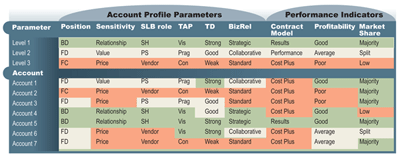
For large sales organizations, account profiling is an essential sales force planning activity. Account profiles offer a summary view of customers’ (or prospects’) characteristics and key issues, often providing the single most important sales force-to-management communication tool for customer issues.
Like many firms that employ account profiles, Schlumberger Oilfield Services, a US$25 billion oilfield technology services and solutions firm, recognized a limitation in their profiling methodology: it focused on financial metrics that often provided little insight into the quality of the customer relationship.
This Sales Management Association Case Study describes the Schlumberger’s Account Relationship Profiling tool, an account planning platform that provided Schlumberger management with improved customer intelligence and enhanced account strategy for Schlumberger’s account teams.
Key Account Profiling as a Strategy Development Tool
For large sales organizations, account profiling is an essential sales force planning activity. Account profiles offer a summary view of customers’ (or prospects’) characteristics and key issues, often providing the single most important sales force-to-management communication tool for customer issues.
Like many firms that employ account profiles, Schlumberger Oilfield Services, a US$25 billion oilfield technology services and solutions firm, recognized a limitation in their profiling methodology: it focused on financial metrics that often provided little insight into the quality of the customer relationship.
This paper describes the Schlumberger’s Account Relationship Profiling tool, an account planning platform that provided Schlumberger management with improved customer intelligence and enhanced account strategy for Schlumberger’s account teams.
SCHLUMBERGER OILFIELD SERVICES
Schlumberger is the world’s leading oilfield services company supplying technology, information solutions and integrated project management that optimize reservoir performance for customers working in the oil and gas industry. The company employs more than 80,000 people of over 140 nationalities working in approximately 80 countries. Schlumberger supplies a wide range of products and services from seismic acquisition and processing; formation evaluation; well testing and directional drilling to well cementing and stimulation; artificial lift and well completions; and consulting, software, and information management. In 2007, Schlumberger revenue was $23.28 billion.
Schlumberger manages its business through 28 GeoMarket regions, which are grouped into four geographic areas: North America, Latin America, Europe, CIS & Africa and Middle East & Asia. The GeoMarket structure offers customers a single point of contact at the local level for field operations and brings together geographically focused teams to meet local needs and deliver customized solutions. Working together with the company’s technology segments, the GeoMarkets provide a powerful conduit through which information and know-how flow to the customers, and through which Schlumberger engineers and geoscientists maximize technological synergies over the entire life of the field.
VALUE OF ACCOUNT PROFILING
Account profiles support multiple marketing and sales objectives for Schlumberger, as they do for most firms. These include:
- Improved segmentation: Account profiles are an important input for customer and market segmentation decisions.
- Resource allocation decision support: Resource allocation decisions, especially quarter-to-quarter (short term), market-specific decisions, often hinge upon customer-specific developments.
- Solution development: Schlumberger’s complex selling environment frequently calls for customized offerings. Account profiles provide a basis for communicating customers’ needs across a diverse set of stakeholders who must collaborate on solution development.
- Sales and account strategy: Account profiles often form the basis of account strategy development.
- “At-a-glance†customer information for management and diverse customer teams.
- Schlumberger’s previous account profiling efforts involved assembling those account characteristics that were objectively identifiable and easily verifiable; for example: customer revenue and profitability, Schlumberger’s product/service offering to the customer, the customer’s organization, etc. Missing from the profile were reliable indicators of more subjective customer characteristics: customers’ interest in partnering with Schlumberger, or customers’ pricing sensitivity, for example. Understanding these relationship-centered account characteristics, Schlumberger management believes, is most crucial to developing effective account strategy and future success. As one put it: “What matters most is not who you know, but how you are known to them.â€
SCHLUMBERGER’S ACCOUNT PROFILING TOOL
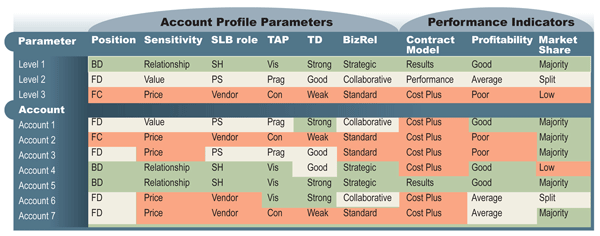
Schlumberger’s account profiles organize information within two areas: Account Performance Indicators, and Relationship Profile Parameters.
Relationship Profile Parameters:
- Account’s perception of Schlumberger value
- Pricing sensitivity of the account
- The Schlumberger role in the account
- Account’s technology adoption profile
- Account’s technical abilities to use Schlumberger services and products
- Account’s willingness to form external partnerships and share value.
Account Performance Indicators:
- Current business and contract models used
- Level of profitability for Schlumberger
- Schlumberger market share.
These profile areas are used to determine Schlumberger’s relationship strength with the account, much like a balance sheet is used to determine a company’s financial strength. The account relationship profile provides a snapshot of the current state of the account that can be used as a basis for building a vision or target for that account over a given period of time.
RELATIONSHIP PROFILE PARAMETERSÂ
Perception of Schlumberger Value
Â
Schlumberger wants to know why its customer purchases Schlumberger products or services and how the customer perceives the value delivered. Adapting Michael Porter’s model for corporate marketing strategy, Schlumberger developed three basic descriptions of a high-level value proposition customers associate with the Schlumberger.
Broad differentiation. Total service company with a global reach and having the resources needed to effectively develop their reservoirs (OFS Solution). The account buys from Schlumberger because our broad differentiation provides them value.
Focused differentiation. Best segment. The customer buys from us because they see Schlumberger as the best in a specific segment offering.
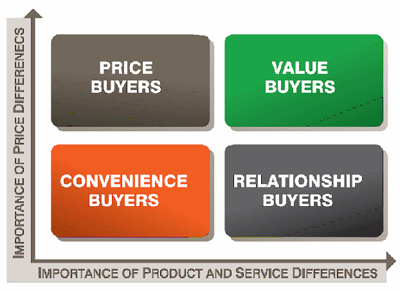
Focused cost. Low-cost provider of services the customer needs. The customer buys from us because they believe we provide what they need cheaper than anyone else. Pricing Product Service Sensitivity Schlumberger again adapted a strategic framework in order to develop four broad buyer-behavior classifications . Illustrated in Figure 2, these classifications are: Price Buyers, Value Buyers, Convenience Buyers, and Relationship Buyers. Figure 3 shows what each of the three main buyer groups perceives as value. Price Buyers. Price buyers seek to buy at the lowest price consistent with some minimum level of acceptable quality that several suppliers can meet. These price buyers do not make feature benefit trade-offs and cannot be convinced to pay more for the unique added value of superior features, service or supplier reputation. Price buyers’ perception of value is the lowest price, without hassles, and consistent products. These buyers know exactly what they are buying and do not want any surprises.

Relationship buyers. Relationship buyers already have a strong preference for one company, based on its unique reputation, its unique features or their past experience with that company. If that supplier company’s prices do not exceed what they are willing to pay, these buyers will purchase from that supplier even if there are cheaper alternatives. Their perception of value is to buy the best total solution for their needs. They want to deal with experts so they can focus on other issues. While they know they are paying a premium over going market rates, they are nonetheless convinced it is worth it.
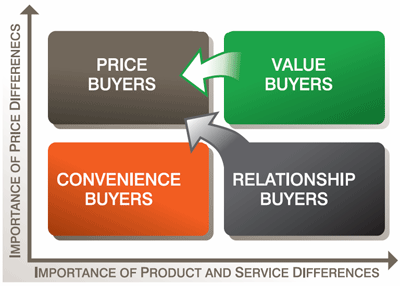
Although these two segments are frequently considered the two ends of a price-quality continuum, the two additional segments reveal additional variation within buyer classifications:
Value buyers. Many customers are price sensitive because they make large expenditures or have limited budgets, yet they are also sensitive to differences offered by various suppliers. These value buyers may buy a relatively high-priced offering but will do so only after carefully checking the prices and features of the alternatives and concluding that the added value is worth the added cost.
Convenience buyers. Value buyers’ opposites are convenience buyers. These buyers are not particularly concerned about the differences among brands. Any brand will do, but convenience buyers are also not particularly concerned about cost. Consequently, they buy whatever is most readily available, minimizing the search and evaluation of prices and features. Schlumberger’s customers in the E&P marketplace rarely if ever meet the definition of true convenience buyers; Schlumberger therefore limited it profile designations to price, value and relationship buyers.
Schlumberger finds that customers in its markets behave consistent with economic theory on buyer behavior. Specifically, market forces create a natural migration of buyers motivated by loyalty and value to price-based motivation. This happens when products and services become more similar over time, differences between suppliers become less obvious and the deciding purchasing factor becomes price. Figure 4 illustrates this migration. Schlumberger observes this behavior in maturing markets – even in markets where Schlumberger constantly introduces value-added products and services.
Convinced that customers assign value to more than just price, Schlumberger management reviewed many specific cases of “buyer migration,†and learned that there were the following underlying causes:
- Lack of customer focus. Schlumberger sales engineers fail to explain the differentiating features and benefits that result in added value for the customer. Consequently, the customer views all or a selected group of companies and their offerings as the same, and simply uses price as the only significant purchasing decisions criteria.
- Less than superior service. Customers may perceive that Schlumberger’s service does not justify a price premium over a competitor. Many studies have demonstrated that customer loyalty is created by superior service – not just good service – and that only total customer satisfaction gives a supplier a competitive advantage. Schlumberger focuses its account service teams on delivering on promised service commitments during project execution stages, pursuing opportunities to tangibly exceed customer expectations, and directly impact buyer and total customer satisfaction.
- Poor pricing management practices. This occurs when pricing is set lower than that for existing value or relationship buyers, thereby reinforcing price buyers’ behavior. Once the value and relationship buyers discover this, they ask for the same prices and behave like price buyers. These pricing practices are most often associated with efforts to increase market share by lowering prices.
The Schlumberger Role in the Account
Schlumberger found that that one of the best ways to determine how it’s perceived by a customer is to identify how it participates with that customer in the customer project management process. Schlumberger classifies its role as one of three alternatives:
- Trusted advisor, or stakeholder;
- Technical or situational advisor, or problem solver; and
- Vendor.
Schlumberger tracks customer project management efforts across six distinct phases: goals, selection, options, procurement, execution, and review. Schlumberger tends to earn trusted advisor status with those customers in which they participate across all stages of project management; conversely, customers that engage with Schlumberger for only the procurement and execution project stages tend to perceive Schlumberger on strictly a vendor basis.
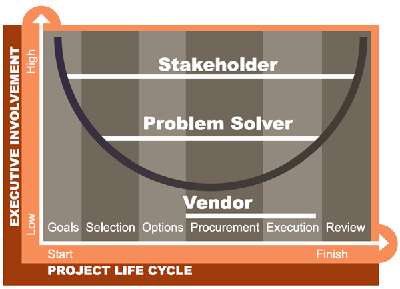
Figure 5 describes typical Schlumberger customer project involvement and a corresponding account role designation. The black line under each role indicates in which stages in the project life cycle Schlumberger participates. The white curved line indicates the amount of executive involvement in each stage of the project life cycle. Typically, executive involvement in the project life cycle is high in earlier stages and then gradually decreases through each successive stage to procurement, when it is lowest. Executive involvement increases again once the project starts and is high again when the results are reviewed. Schlumberger contact with customer management during the project stages is a good indicator of our role in the account. Trusted Advisor. Customer views Schlumberger as a stakeholder, interested in optimizing the performance of customer operations. Schlumberger has demonstrated its concern that the customer achieves their goals and objectives, and participates in all six stages of the customer’s project life cycle.
Problem Solver. When perceived as a problem solver, Schlumberger works primarily as a technical specialist with the customer account. This perception can apply to specific products or services, or can apply only to a specific situation, such as Schlumberger’s expertise in offshore development. When this is Schlumberger’s role, it is typically involved in the later part of the project selection stage, in the evaluation of options stage, and on through to the review of results stage.
Vendor: Schlumberger is relegated to a vendor role when its customers involve the company in a project only during the bid tender and procurement process stages. If a contract is won, Schlumberger also participates in project execution. There is little contact with Schlumberger’s executive level and the customer, and Schlumberger’s influence open customer purchasing requirements or strategy is limited.
Account’s Technology Adoption Profile
This profile measurement area classifies customers’ speed and efficacy in adopting new technologies. Schlumberger finds that customers’ eagerness to adopt new technologies in day-to-day operations within their revenue-generating assets correlates strongly with Schlumberger’s opportunities to provide customer value. In judging this account profile parameter, Schlumberger considers what end users need and how quickly they adopt new technologies.
In profiling customers’ technology adoption characteristics, Schlumberger categorizes customers as visionaries, pragmatists and conservatives.
Account’s Technical Depth
Technical depth refers to customers’ internal ability to use Schlumberger’s products and services to their fullest potential, or whether the customer has the internal technical expertise to extract full value from Schlumberger’s offerings. Technical depth is classified as strong, good or weak.
Strong technical depth describes companies with an advanced level of technical capability. Strong companies sometimes have specialists whose technical knowledge equals Schlumberger’s own experts. Typically, visionary companies have strong technical depth.
Good technical depth describes companies that have internal technical departments to assist end-users in adopting and applying Schlumberger technologies in their operations.
Weak companies do not have the resources necessary to stay abreast of available technologies and need assistance in using Schlumberger’s products and services. Companies that have invested in the E&P industry, who do not have the traditional E&P experience or structure, are often classified as weak.
Account’s Willingness to Form Advanced Business Relationships
This measurement area is used to identify accounts that are potential targets for participating in advanced business relationships. From an account management perspective, this factor helps to identify which accounts would be more receptive to value-added cross selling proposals. There are three categories used for this profile category, which are summarized in Figure 6.
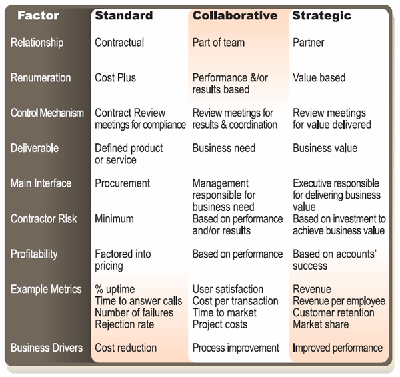
Standard. A standard account is one that will only consider the basic contractual supplier–customer relationship. For these accounts, the contractor provides a defined deliverable based on a cost-plus contractual framework. In this type of relationship, the customer’s main objective is to get what he asked for typically through a tendering process. Business drivers of the account include the quality of the service and cost reduction. The customer typically measures supplier performance using factors such as system availability, total spend, costs reduction targets, etc. Once entering the procurement phase, procurement and contract departments largely handle supplier discussions. The key control mechanism used by accounts for this type of relationship is the signed contract and service review meetings to ensure deliverables have been satisfactorily delivered. For this type of business relationship, there is very minimum risk for the contractor and very little potential to earn more profit then factored into their contract for requested services. Collaborative. A collaborative account is one that has already participated in a more cooperative business relationship or is actively discussing prospects to test this type of relationship. The collaborative business relationship is where the contractor engages the customer to find the best solution to their business needs. The supplier is considered to be very much part of the project team. Decisions are taken after options have been openly discussed and evaluated between the business partners. It is not usual that the deliverable to the customer includes some form of management responsibility, typically of products or services provided in standard type relationships.
Remuneration goes beyond the standard cost-based systems and include some form of supplier gain-sharing. In this model, the supplier risks portion of his remuneration based on benchmarks for levels of performance and results. If benchmarks are achieved, then contractors receive bonuses; if they are missed, contractors will be assessed a penalty for not achieving benchmarks. The drivers for this type of business relationship include speed to market, access to the contractor’s larger resource base of skills and resources, the need for commercial flexibility, scalability and rapid response.
Metrics for this type of relationship include improvements in performance, on-time project delivery, user satisfaction, etc. During supplier selection, the procurement and legal departments play less of a role and the management initiating the collaborative approach will stay involved throughout the selection process. The key control process for this type of business relationship is regular operating review meetings for results delivered and coordination issues.
Strategic. In a strategic partnership, the partners are far more dependent on each other for the delivery of business value. Customer discussions revolve around what the strategic partner will be responsible for in terms of processes and business needs, leaving the details of what and how this is done to the strategic partner.
In a strategic partnership, each partner works to ensure the other is financially successful. Supplier remuneration is linked to agreed-upon business results. Risks can be higher than the collaborative relationship depending on what the contractor wants to invest in the relationship to achieve better results for the account; however, the improved results should result in a significant benefit for the contractor. In this type of relationship, the service provider typically takes responsibility for complete project of business process. In this type of relationship, it is not usual to have the contractor’s research and development focus on the customer’s specific needs or to participate in joint research and development. The client utilizes the full resources of the partner to maximize the value to their business.
Metrics for this type of relationship are direct corporate value drives such as revenue, profit, earnings per share, etc. Strategic relationships are driven by business strategy; as such, in the selection of the strategic business partner, the executive of the business units who are dependant on the strategic partner will be very active throughout the selection processes. In most cases a strategic partner will not be a new provider, but a company that the account has worked with previously. In these types of strategic relationships, the main control process is a regular review meeting for value delivered.
ACCOUNT PERFORMANCE INDICATORS
Account performance indicators make up the second part of Schlumberger’s account profile format. Account performance indicators are focused in three measures: the customer’s business and contractual model, customer profitability, and Schlumberger market share.
Business and Contractual Model
Schlumberger offers customers a full range of business and contractual models for their various projects, and it classifies accounts according to their preferred business model. For this profile measurement area there are three business model classifications: cost-plus for basic models; and performance-based and results-based for advanced models. Each advanced model requires successively higher levels of cooperation, trust, and alignment of operator and supplier objectives. The ultimate goal for the advanced models is greater profitability for both the customer and Schlumberger.
Basic Models. All basic models are classified as cost-plus, and are used for products and services charged at cost plus a mark-up based on quantities used. Two common variations of the basic model are volume discounts and turnkeys. Volume discounts recognize that as volume efficiencies are gained, part of the cost saved is shared back with the account through volume discounts. Service bundling offered without a performance- or results-based remuneration component in the contract falls in the basic category under the volume discount scheme.
For turnkey or lump sum contracts, the customer sets specifications, and jobs are bid by project. The selected service company then executes the job on demand. The supplier’s incentive is to complete the job as quickly as possible to earn the greatest profit. If the supplier has problems completing the job or project, the contractor earns no more than the turnkey, or lump-sum price.
Advanced models, in addition to a product and service fee, include a risk or reward component as an incentive portion of the remuneration. The risk or reward component can be based on the supplier’s performance, project results or asset value creation. The main difference between the various advanced models is the level of risk Schlumberger is willing to accept and the level of customer willingness to outsource and share value creation.
Performance-based contracts include integrated services and processes. These business models span a range of activities, from service execution—performing bundled services—at the basic end, to product delivery—such as providing a completed well or offshore platform—at the most sophisticated end. These types of projects usually include conceptual design, process planning, service execution and evaluation. Typically, results-based contracts include engineered solutions, with performance incentives when established benchmarks are bettered or surpassed, or discounts from the going market rate when benchmarks are missed.
Value-based contracts include joint value enhancement projects. Schlumberger exposure in these types of projects is limited, and profits are capped because Schlumberger does not take an equity position in any project. Compared to other business models, the expected profit from a value-based contract is greater for both the customer and Schlumberger.
These value-based customer relationships are considered by Schlumberger to be alliances: long-term arrangements that further Schlumberger’s and the customer’s common interests over a specific range of activities. As such, these arrangements differ from Schlumberger’s integrated services contracts. Under an integrated services contract, the client assigns responsibility to the supplier to reduce the client’s costs. In such alliances, Schlumberger accepts responsibility for reducing customer costs, and the customer accepts responsibility for ensuring the Schlumberger’s profit, often by assuring future business and sharing gain. The two sides work together to reduce costs and improve profitability for all involved.
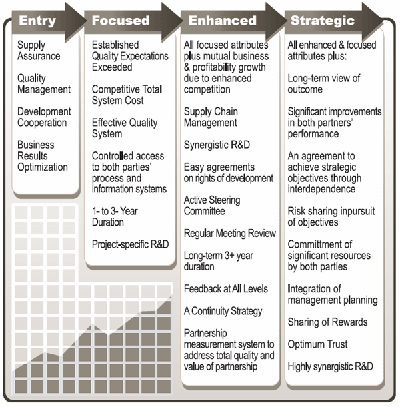
Integrated services and alliances are not mutually exclusive. An integrated services project may be offered to an alliance partner, or may evolve into an alliance. In fact, most of Schlumberger’s customer alliances start out as tests for a certain period of time. If successful, alliances may become self-renewing, or “evergreen.†Schlumberger’s customer alliances evolve with time. The company differentiates between four types of alliances: entry, focus, enhance, and strategic. Figure 6 lists the features of each type of alliances Schlumberger engages in with its customers. “Strategic alliance†describes customer alliances that are closely linked with a supplier’s business strategy, and implies an open sharing of strategic information between customer and supplier. Few oilfield services industry alliances between suppliers and customers (including Schlumberger’s) have reached such a level of cooperation and openness, but that is the goal to which many aspire. Schlumberger’s customer relationships based on shared investment and joint problem solving share a common characteristic: a reduced emphasis on price as the primary supplier-selection criteria. A Schlumberger customer described his firm’s change in decision process as follows: “Historically, we placed a great deal of emphasis on the lowest possible bid. All that changed when we stopped focusing on price alone and placed more emphasis on the significant few oil and gas fields, technologies and relationships that contribute to performance.†—Oil Company Manager
These relationships often involve a substantial investment on Schlumberger’s part; for example, by providing dedicated, on-premise field support engineers capable of solving technical issues for customers. In the old “vendorâ€/customer model, as a Schlumberger field support engineer points out,
…the client might say, “Here’s my pump schedule. Be ready to roll Tuesday morning at 5.†Now the client might say, “Work with our team to develop a completion plan for this well that gives both companies the highest value.†Oil companies are beginning to realize there’s benefit in trusting us to meet or exceed their criteria for job performance.
Profitability
Profitability is a measure of profit made at the account level. Schlumberger’s consideration of account profitability includes both the direct operational costs and revenues generated from the account plus its servicing costs. Servicing costs include a portion of the overhead that is dedicated to meeting an account’s needs. This includes the costs of support personnel, such as technical support engineers, and other staff dedicated or shared among accounts. It also includes any ongoing and special carrying costs such as invoices open beyond the standard terms and conditions, holding of inventories for future work, etc. Profitability also depends upon the prevailing local market conditions.
Schlumberger uses the following classification scheme for account profitability:
- Level 1, the best profitability at the local market level
- Level 2, average profitability at the local market level
- Level 3, below average profitability at the local market
Schlumberger Market Share
Market share is a measure of Schlumberger’s portion of the total market for products and services available to Schlumberger for an account. Schlumberger makes sure any measure of potential is relevant to the customer (not simply to Schlumberger). It classifies share based on three broad estimates: majority, split or low market share.
ANALYZING THE ACCOUNT RELATIONSHIP PROFILE

The account relationship and performance indicators discussed above are presented in summary form in a table (Fig. 7) . This summary view provides insight into the current account relationship and identifies gaps that exist in comparison to the targeted relationship. Building an accurate account relationship profile requires collaboration with everyone who works on an account. First, the “Performance Indicators†section is completed for each segment working with the account; these indicators are then consolidated to arrive at a consolidated company view of the account. Each parameter has been color coded to highlight inconsistencies or gaps in the relationship with the account. Account relationship profiles are categorized as Level 1 (blue), Level 2 (green) or Level 3 (red). These levels represent the model relationships that allow Schlumberger to discuss the account strategically and to build a plan for migrating or strengthening the relationship.
Account Relationship Migration Strategy
The account relationship profile matrix is completed in preparation for planning an account migration strategy. Schlumberger’s account strategy includes envisioning the type of relationship (Level 1, 2 or 3) desired with the account, identifying the benefits of such a relationship for both the account and for Schlumberger. As a next step, Schlumberger’s account managers are asked to answer a series of questions related to a set of topics, or planning imperatives. These questions must be answered for each of the accounts and then prioritized at the local market level to ensure the best use of limited resources to serve the market.
Planning imperatives for account migration strategy:
- Management alignment
- Long-term advantage
- Sufficient resources
- Budget
- People Long-Term Advantage
- Equipment
- Competitive threats
- Additional costs
Management Alignment
Which relationship level does the account’s management believe extracts the greatest amount of value for meeting their objectives (Level 1, 2 or 3)? Schlumberger believes efforts to change the way companies interact require support from the account’s management to avoid wasting resources on a strategy that is unlikely to succeed.
Long Term Advantage
What is the future activity level of the account in the local market? Does the account warrant dedicating additional resources to migrate to a Level 1 or 2 relationship? Is there time to achieve what Schlumberger wants to accomplish with the account
Sufficient Resources
Does Schlumberger have the operational resources to commit to meeting the account’s expectations? Answers to resource questions include not only sufficient products or tools, but also people to service the account (field, sales and other support personnel). If the required resources are brought into the local market, does the local market have a sufficient budget to support them? Does the local market have sufficient funds to purchase assets or make other required investments
Competitive Threats
Competitive threats may require building barriers to entry to the account by migrating the account to a Level 2 or 1 relationship. New competitors to the local market may focus on Level 3 accounts, as entry points to these accounts are easiest to penetrate. This is especially true in mature development markets where the technical challenges of oil field production have already been addressed or the fields are in the decline stage. At this stage, asset management may focus heavily on reducing costs. In such an environment, customers may be persuaded to try new suppliers under the promise of lower costs.
Additional Costs
Account relationship strategies involve investment from Schlumberger, increasing its cost to serve. To migrate an account from a Level 3 relationship to a Level 2 relationship increases Schlumberger’s costs since it provides value-added products and services at that level. Migrating an account from Level 2 to Level 1 increases our costs for support through increased operations costs (dedicated field support managers), additional sales support or technical support engineers. Before migrating these accounts, Schlumberger management must make sure that its increased cost to serve is matched by customer willingness to compensate Schlumberger for the increased investment—either through improved efficiencies, volume of work, better pricing or by using an advanced-level business and contract model. Schlumberger sales engineers must be careful not to assume that migrating all relationships to higher levels is appropriate. Since resources at the local market level may be limited, it is unrealistic to assume that all accounts can be Level 1 relationships. But the above questions can assist in identifying which accounts are the best candidates for higher level relationships.
Schlumberger also wants to provide excellent service to Level 3 accounts while keeping the costs of servicing those accounts as low as possible. This trade-off may require taking assets and other resources from Level 3 accounts and deploying them to Level 2 or Level 1 accounts that are willing to pay a value premium us for the additional resources.
Migration Path
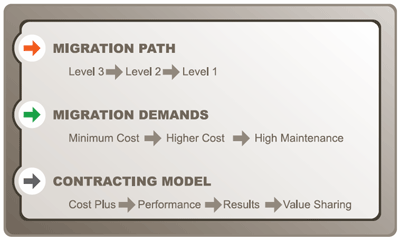
The migration path for an account moves from Level 3 to 2 to 1. For example, if Schlumberger wants an alliance-type relationship with a Level 3 account, it must first migrate the account from “price†buyer to “value†buyer (Level 2), then to “relationship†buyer (Level 1). Along the way, Schlumberger must also maintain all other relationship parameters at a level consistent with the level of the desired relationship. Figure 8 illustrates this migration path.
EXAMPLE ACCOUNTS
Representative profiles and strategies for three of the accounts represented in the example matrix are provided below in outline form.

Account 1
Account Profile
Â
- Perceives Schlumberger as best-in-class service provider.
- Recognizes value in a supplier pursuing a focused differentiation strategy.
- A “value†buyer that views Schlumberger as a problem solver because with a high level of technical expertise.
- Strong technical capabilities in-house, though tends toward pragmatism in technology investments — that is, they wait to buy new technologies until they are proven.
- A cost-plus contract is in place at profitability Level 1.
- Receptive to Schlumberger’s past efforts to implement an advanced business relationship, though this only resulted in limited performance bonuses in contracts.
- Schlumberger has the majority of this account’s market share.
Strategy
- Schlumberger considered implementing advanced-level contractual arrangements, such as results-based pricing. In-house expertise may limit this opportunity, however.
- Schlumberger ultimately supported this customer’s in-house experts with advanced technology seminars, VIP seminars highlighting successful new technology applications, and examples of advanced business relationships from other accounts to create awareness of other options.
- Schlumberger also held regular service quality review meetings to highlight major operating successes, failures, and improvement initiatives.
Account 2
Account Profile
Â
- Views Schlumberger as a best-in-class provider for their specific service requirements (a “focused differentiation†customer value perception).
- Claims price is most important purchase decision criteria, but enjoys significant Schlumberger participation in problem solving, including developing bid specs.
- Pragmatic in adopting technology. with good technical depth.
- Schlumberger has a cost-plus contractual model, with Level 3 profitability; alternative pricing or partnering models have not been discussed.
- Schlumberger enjoys the majority of this account’s wallet share.
Strategy
• Improve Schlumberger’s profitability in the account through the following:
- Acknowledge and leverage Schlumberger’s ability to raise pricing, rather than conceding price objections. This approach is justified based on clear value customer receives from Schlumberger value-added services.
- Solicit support throughout the organization by clearly communicating the value generated by the Schlumberger dedicated account team and support resources.
- Inform supporters within the account that Schlumberger’s pricing is too low, and are expected to increase in the next contract period. Where possible, gather supporters’ input and coaching advice on how to successfully “sell†price increases without loosing customer share.
- Initiate discussions with customer management on utilizing advanced-level business models, since performance- or results-based contracts could be one way to justify increased prices.
Account 3
Account Profile
Â
- Large, multi-national firm
- Perceives Schlumberger as one of three leading oilfield service companies; Schlumberger’s role is that of “vendorâ€
- Account profitability is at Level 2
- This account splits purchases among several vendors, typically tendering requirements to all three leading competitors, then awarding contracts to two of the three competing suppliers in a 50/50 split. This strategy is intended to obtain services at the lowest possible price.
- Technically strong, with a visionary technology adoption profile and strong technical depth.
- Initial conversations have been held regarding advanced-level business models; to-date, only one small integrated project has been completed. All other work is provided on a cost-plus business model basis.
Strategy
Two strategies can be considered for managing Account 3:
- Change nothing. Account profitability is at Level 2, and it has been difficult to get involved in their project cycle before the procurement stage. Account 3 management does not believe our staff or our competitors’ staffs offer any benefits, and they believe their in-house expertise is adequate. The strategy of not working to improve the relationship, however, may prove faulty, since at any time Account 3 may choose a competitor to do the work.
- Work to understand Account 3’s value drivers and determine where Schlumberger can differentiate its value proposition from competitors’. Then, bring to the GeoMarket a recognized Schlumberger industry expert to participate in venues that raise this customer’s awareness to create a buying environment.
By adopting the second strategy, Schlumberger would seek to migrate Account 3 to a value buyer after the account has recognized Schlumberger’s differential value and begins to view its role as that of a problem solver. If this strategy is unsuccessful, this account should be treated as a Level 3 account, minimizing our costs to service the account and applying a two-tier pricing approach.
It is also important for Schlumberger to understand why this account participated in one integrated project but has not expressed desire to extend the arrangement to other projects. Sales engineers may also want to spend time learning how to differentiate themselves from the competitor’s representatives. A one- to two-year time period can be expected to implement the strategy for Account 3.
CONCLUSION
Account relationship profiling is a valuable tool for assessing the status of the account relationship. A completed profile provides a snapshot in time for planning account development. Accurate profiling and analysis are essential to deciding which actions are likely to better align the account and build a profitable relationship. Like a marriage, both parties must agree that advancing the relationship level will mutually benefit both companies. Where there is not management alignment and support for more advanced relationships, Schlumberger ensures that a basic relationship still delivers total customer satisfaction.
The account relationship profile is always analyzed from the customer’s perspective and can be carried out at the segment, central HQ, or local-market-level. Schlumberger recommends starting the exercise at the segment level and then compare with other segments’ analysis to arrive at a consensus profile. Schlumberger also recommends gathering input directly from the account in order to gain a good understanding of the customer’s perspective.
About The Author

JP Amlin graduated from the Royal Military College in Kingston, Ontario Canada in 1980. Immediately upon graduation he started with Schlumberger as a wireline field engineer working in the Eastern and Arctic regions of Canada. He has held management and executive positions in both operations and marketing in North America and Asia. In 1999 he became the Oilfield Sales Training Manager and has developed and delivered sales, account management and sales management seminars across the globe to Schlumberger staff in the areas of sales and sales management. In 1987 while stationed in Alaska as the Area Marketing Manager he earned his MBA from the University of Alaska, Anchorage upon graduating he lectured in the business department. After his masters degree he published two comprehensive reports – one dealing with the critical factors influencing sales effectiveness in industrial sales, and another study on the competitiveness of the oilfield services sector both of which over the last 20 years he has continued to research. In 1999 Mr. Amlin published an internal sales handbook, and in 2003 published an internal sales textbook covering marketing, account management, and selling in competitive markets. In addition he has published, and presented several papers on customer-supplier relationships, and account management.









